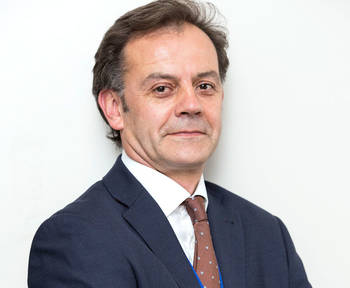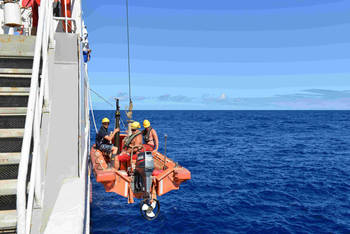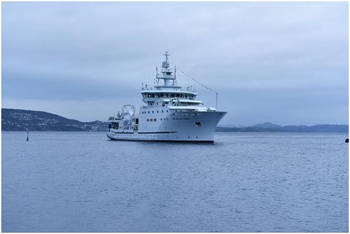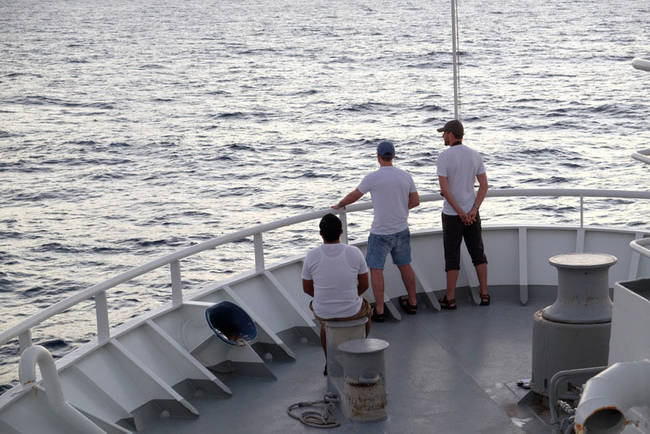FAO Fisheries’ Director recalls his experiences aboard the Nansen
Manuel Barange joined FAO this past May as its Director of the Fisheries and Aquaculture Division of the Fisheries and Aquaculture Department, but prior to assuming this position, he had a long history of collaboration with FAO, and in particular with the FAO-Norway Nansen programme.
As we await the imminent launch of the new marine research vessel, the R/V Fridtjof Nansen in Oslo, Norway on 24 March, we felt it would be a good opportunity to speak with Mr. Barange about his voyages – an impressive five of them aboard Nansen vessels - and to ask about his hopes for the next phase of this unique FAO-Norway collaboration on marine research, primarily in developing countries
You have undertaken five survey voyages aboard the Nansen vessels. How did you first become involved with the Nansen, and with which survey voyages did you take part?
I became involved with the Nansen programme around 1991-1992, when I was working as a scientist for the South African Sea Fisheries Research Institute. I was first asked to attend a workshop in Namibia where the Dr Fridjof Nansen’s scientists were discussing fish surveying techniques in Namibian waters.
My first interaction was actually quite tense: I felt their methods were inferior to the ones we were using in South Africa, and I was convinced they were not as advanced as what they would use in Norway. I was young and outspoken! But the interactions were nevertheless positive and led to many cooperative experiences; I have many excellent memories of them.
At the time we were putting together a big regional programme in southern Africa (BENEFIT was its name), and the Nansen became one of the standard survey platforms we used. I was very involved in the design of regional work that required the use of the Nansen, both as a BENEFIT lead scientist and official of the South African government. As the latter we had annual meetings with Intitute of Marine Research (IMR) staff where they would tell us what ship’s availability they had and we would pitch particular ideas for research.
I recall sailing on Nansen several times: an intercalibration cruise with another South African vessel testing our fishing gear, a pelagic schooling cruise using new Sonar technology available on the Nansen only, a demersal stock assessment cruise, a fish ecology cruise which conducted 24-h samplings in specific regions, and an orange roughy stock assessment cruise.

- Work on board can be grueling and long, but most scientists are extremely positive about the experience. As Barange notes: “Sea-going scientists form strong bonds because life at sea is tough: you all muck together, get sick together, and celebrate together.”

- Speaking about the Nansen programme, FAO Director Manuel Barange reflects that “The Nansen programme turns marine graduates into marine scientists. [The onboard research experience] is life changing, in many ways.”

- The old Nansen vessel harboured at Port Louis, Mauritius.

- Innovative research takes place on the Nansen, such as the first-ever deployment of these Argo floats in the Indian Ocean.
There must have been others but cannot recall them all – at the time I was doing about 100 days at sea a year, and the cruises became a bit indistinctive! They were always conducted in Namibian or South African waters between 1992 and 1999. I also had a barbeque floating on the previous Dr Fridjof Nansen ship as she was being decommissioned. It was a beautiful old ship, but of course without the comforts and technologies of the last Nansen.
What were some of your most memorable experiences aboard the Nansen?
At sea one works “shifts” of either 4, 6 or 8 hours, so often you wake up in time for lunch or dinner, perhaps stumbling into the canteen without paying much attention to the menu. One day I sat down sleepily and got a plate of food in front of me that looked like a burger. I don’t normally eat meat but was too tired to argue, so I took a bite. It tasted funny so I asked what it was – it was whale meat! I went to work on an empty stomach that day… But jokes aside some of the most memorable moments to me where to observe the level of equality between the crew on the Nansen.
In South African vessels, deckhands never really interacted with officers (they did with scientists when we were all on deck working, but not socially). In the Nansen it was so different: they were all a family, had meals and coffees together as equals. It was an eye opener. Otherwise it was a very comfortable working platform – one of the best.
Things that for us were luxuries for them were standard. For us sailing on Nansen was like a paid holiday, even though we worked incredibly long hours. We also met scientists from other countries, and that was always enjoyable.
Why is this long-standing FAO-Norway partnership aimed at promoting marine research so unique?
Because there is no other platform like it! I believe it is the only research vessel that flies the UN flag, and it operates in some of the least observed waters in the planet, particularly in Africa. As a result, most oceanographic earth models are negatively biased – we just don’t have enough observations of waters in the southern hemisphere, especially in Africa.
The Nansen is helping change this. But this is not the main reason for the Nansen programme. Its goal is to provide a platform for countries with very limited capacity to assess their fisheries to do so properly and with support.
This allows them to develop and manage their resources effectively and for their benefit. It is an incredible offer from Norway, and a great opportunity for FAO to implement the Ecosystem Approach in situ.
Many scientists tell us how they appreciate the international team aboard the Nansen, each bringing aboard and teaching about his or her specific area of expertise. Was this a rewarding aspect of your time on the Nansen?
Yes, it was rewarding! To be frank, South Africa at the time had very strong and developed fisheries research, assessment and management in place. Our interest in the Nansen was primarily to develop new ideas, test hypotheses and techniques. We could not do this in our vessels because equipment was not as advanced and time at sea much more limited. We also wanted to work with scientists from Namibia and Angola, and the networks the Nansen allowed us to develop were very strong and remained strong for years.
Sea going scientists form strong bonds because life at sea is tough: you all muck together, get sick together, and celebrate together. You get very close, and so are the institutions you represent. The Nansen helped southern Africa, a region ravaged by war and conflict, develop a common vision.
How do you think these experiences positively influence the scientists’ work when they return to their universities, research institutes, government positions and ministries?
For some the Nansen cruises may have been the first and even the only time they got to do hands-on work at sea. Imagine being a lawyer and never going to a court of law, or a surgeon without a hospital.
The programme turned marine graduates into marine scientists. It is life changing, in many ways; some may even decide oceanography is not for them. I think the Nansen gave most of them enormous confidence to teach, to explain, to process data, knowing where it comes from and how it is collected.
Why is work conducted on the Nansen so important at the country, regional and international levels? Do you believe that Nansen survey work can help us contribute to Sustainable Development Goal 14 – protecting life under water?
Absolutely, but it is easily understood if you turn the question around: how can countries without sea going infrastructure contribute meaningfully to an SDG that refers to life under water? The Nansen is, in many countries, the only source of independent information on their marine environment and resources. It is invaluable, and countries always ask for more surveys, never less. We can still make better use of the data collected on the Nansen, and SDG14 targets will give countries the opportunity to do so – in general, data is underused.
We have an exciting new, state-of-the-art research vessel launching in Oslo’s harbor on 24 March, and ready to set sail on future survey voyages. What are your hopes for the Nansen programme in this next phase?
I think the new phase of the Nansen will be a significant shift to its original programmatic objectives. Originally it was a platform to identify and help exploit resources sustainably. It then evolved to focus on the implementation of the Ecosystem Approach to Fisheries, through sampling at sea and management training on land. In the next phase this will continue, but we will see an additional opportunity to provide baseline information on the state of the marine environment and its resources.
At a time when climate change covers most front pages we need actual observations to validate and improve predictive models. Unfortunately, the waters surrounding the African continent are some of the least observed waters in the world. The Nansen is changing this – and it is needed to make sure African waters are not forgotten.
Thank you to FAO Fisheries and Aquaculture Division Director’s Manuel Barange, for bringing his own experiences into the discussion while explaining the importance of this unique FAO-Norway cooperation on marine research.
You can read about some of the previous Nansen survey voyage in our #EAFNansen blogs and learn on the EAF-Nansen project web site
Follow the naming ceremony in Oslo live on 24 March through @FAOKnowledge, @FAONews and @FAOFish accounts, and through the hashtag #EAFNansen.







